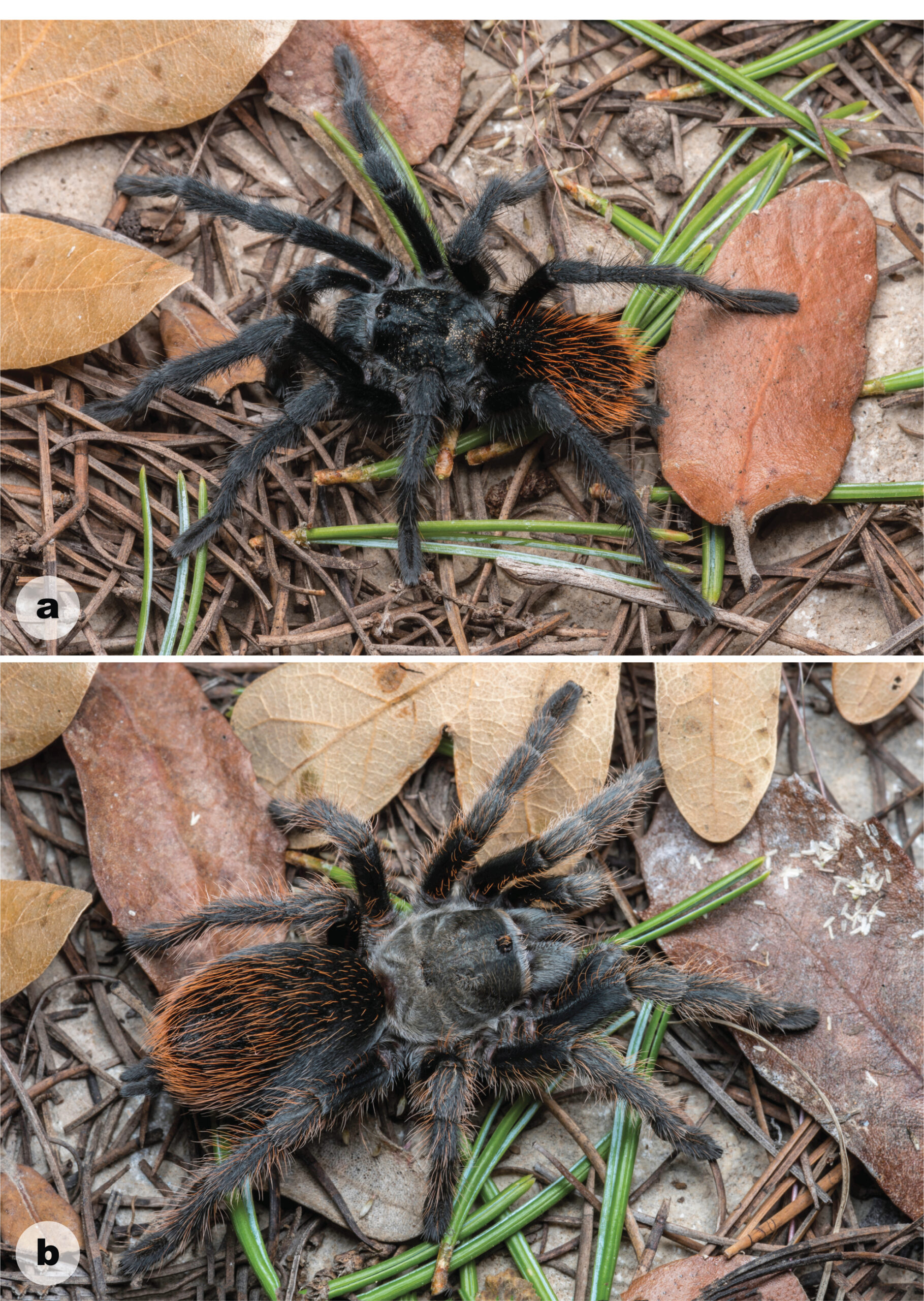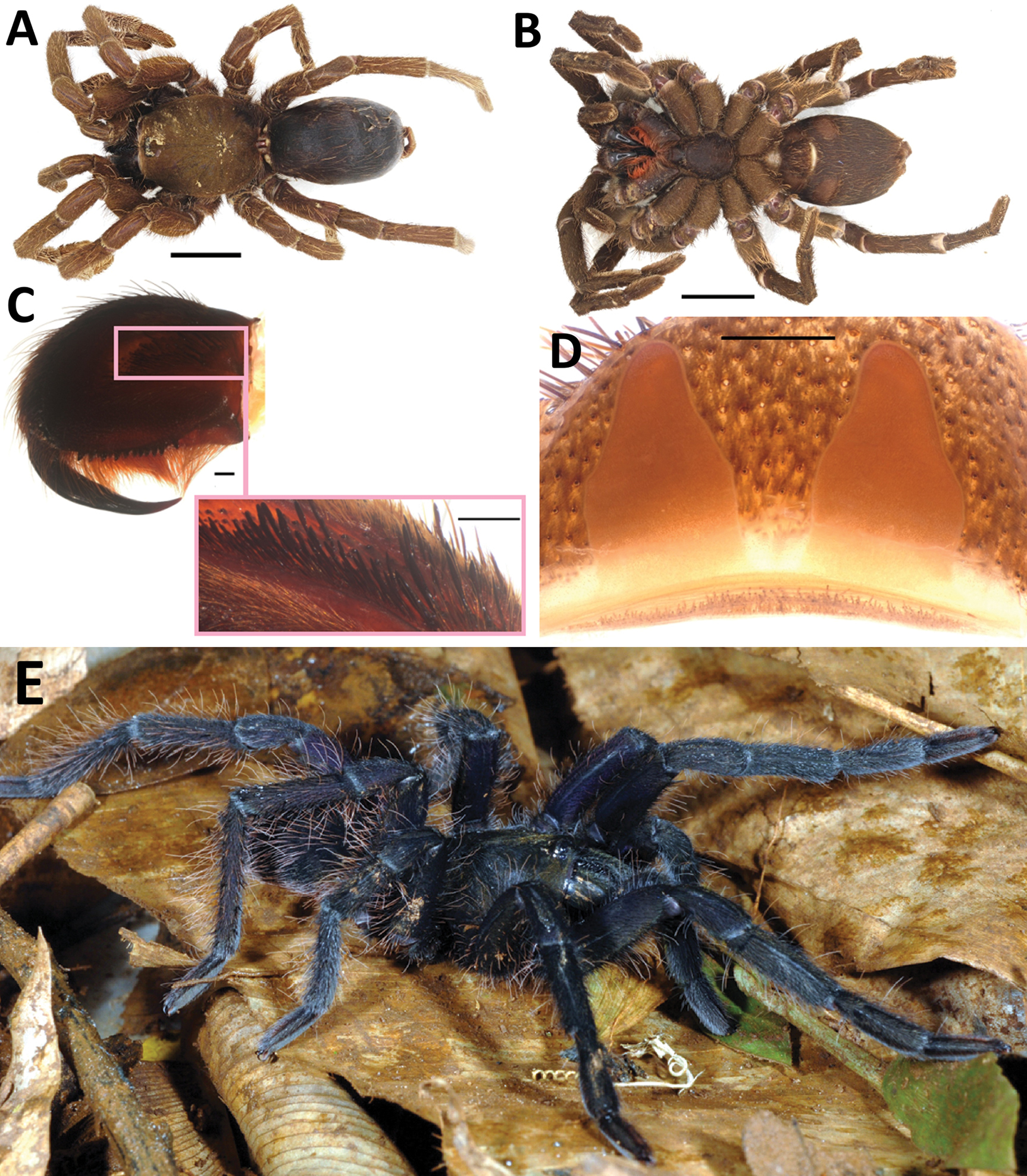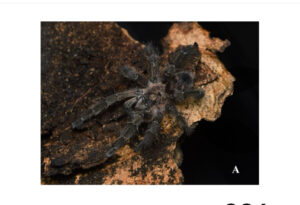Hamilton CA, Hendrixson BE, Silvestre Bringas K (2024) Discovery of a new tarantula species from the Madrean Sky Islands and the first documented instance of syntopy between two montane endemics (Araneae, Theraphosidae, Aphonopelma): a case of prior mistaken identity. ZooKeys 1210: 61-98. https://doi.org/10.3897/zookeys.1210.125318o

Abstract
The Chiricahua Mountains in southeastern Arizona are renowned for their exceptional biodiversity and high levels of endemism. Morphological, genomic, behavioral, and distributional data were used to report the discovery of a remarkable new tarantula species from this range. Aphonopelma jacobii sp. nov.inhabits high-elevation mixed conifer forests in these mountains, but also co-occurs and shares its breeding period with A. chiricahua—a related member of the Marxi species group—in mid-elevation Madrean evergreen oak and pine-oak woodlands. This marks the first documented case of syntopy between two montane endemics in the Madrean Archipelago and adds to our knowledge of this threatened region’s unmatched tarantula diversity in the United States. An emended diagnosis and redescription for A.chiricahua are also provided based on several newly acquired and accurately identified specimens. Phylogenetic analyses of mitochondrial and genomic-scale data reveal that A. jacobii sp. nov. is more closely related to A.marxi, a species primarily distributed on the Colorado Plateau, than to A. chiricahua or the other Madrean Sky Island taxa. These data provide the evolutionary framework for better understanding the region’s complex biogeographic history (e.g., biotic assembly of the Chiricahua Mountains) and conservation of these spiders.
Sherwood D, Henrard A, Van Den Spiegel D (2024) Selenogyrus foordi, a new species and the first record of the subfamily Selenogyrinae Smith, 1990 from Guinea (Araneae, Theraphosidae). African Invertebrates 65(2): 37-48. https://doi.org/10.3897/afrinvertebr.65.128284

Abstract
A new spider species, Selenogyrus foordi sp. nov. (♂♀), is described from Mount Nimba, Guinea. Consequently, we provide the first in vivophotographs of a selenogyrine in the scientific literature and the first record of SelenogyrinaeSmith, 1990 from Guinea. We also record S.aureus Pocock, 1897, described from Sierra Leone, from Massif du Ziama Biosphere Reserve, Guinea, representing the second known species for this country.
Santos, G. de los & Bertani, R. (2024). A new species of the Hispaniolan endemic genus Antillena Bertani, Huff and Fukushima, 2017 (Araneae, Theraphosidae, Aviculariinae), with notes on the natural history of the genus. Zootaxa 5493(4): 419-430.
https://mapress.com/zt/article/view/zootaxa.5493.4.7

Abstract
Theraphosidae is the most speciose mygalomorph family, and its species are usually fossorial, but arboreal species are known in various subfamilies. One of these subfamilies, Aviculariinae, is composed exclusively of arboreal forms and is distributed in the Americas and the Caribbean. Seven genera of this subfamily were described in 2017, including the monotypic genus Antillena Bertani, Huff & Fukushima, 2017, which is endemic to the Dominican Republic. It presents some remarkable features concerning genitalia shape both in male and female, distinct from all other aviculariine species. Herein, we describe the second species of Antillena, A. miguelangeli sp. nov., along with field-note observations and new records for Antillena rickwesti Bertani & Huff, 2013. Males of the new species have a longer and slender embolus on the bulb, and the keels are poorly developed. Females have the spermathecae plateau-shaped with its distal sclerotized half of an elliptical appearance. The new species also represents the first record of this genus from the northern region of Hispaniola.
Moeller, W., Galleti-Lima, A., & Guadanucci, J. P. L. (2024). New species of tarantulas from Brazil and notes on the Hapalopini tribe (Araneae, Theraphosidae, Theraphosinae). European Journal of Taxonomy, 947(1), 53-87. https://doi.org/10.5852/ejt.2024.947.2611
Abstract:
The monophyly of Theraphosinae is supported by both morphological and molecular phylogenies. However, intergeneric relationships often show polytomies and branches with low support. A previous phylogenetic study proposed an intergeneric relationship for the subfamily based on molecular data and divided it into three tribes: Grammostolini, Hapalopini and Theraphosini. However, not all genera of Theraphosinae were sampled, and some relationships were inferred based on morphological similarities. Regarding the Hapalopini from Brazil, the relationships of some genera are still uncertain, such as Kochiana, Catanduba, and Munduruku. In this paper, we describe four new species of Hapalopini from Brazil: Cyriocosmus paresi sp. nov., Hapalopus akroa sp. nov., H. guidonae sp. nov., and K. fukushimae sp. nov. In addition, we propose an updated diagnosis for these three genera and for the species K. brunnipesand M. bicoloratum.
REVISIÓN TAXONÓMICA DEL GÉNERO HOMOEOMMA AUSSERER, 1871 (ARANEAE; THERAPHOSIDAE) EN CHILE, CON DESCRIPCIÓN DE CUATRO NUEVAS ESPECIES. Rubén Montenegro Vargas & Milenko A. Aguilera . (2024). Revista Ibérica de Aracnología. 44. 85-96.
Abstract:
The diversity and distribution of the genus Homoeomma Ausserer, 1871 in Chile is updated. Four new species are de- scribed: H. toriyamai sp. nov. (♂♀) and H. minimum sp. nov. (♂♀) from the Metropolitan Region, H. poqui sp. nov. (♂♀) from the Libertador General Bernardo O’Higgins Region and H. espinozai sp. nov. (♂) from the La Araucanía Region. New distribution rec- ords are given for H. chilense and H. orellanai. Finally, an identification key for the Homoeomma species present in Chile is provided, as well as a distribution map.
Tarántulas chilenas de la subfamilia Theraphosinae (Mygalomorphae: Theraphosidae): una revisión a nivel de género. Rubén Montenegro, Milenko A. Aguilera. June 2024. REVISTA CHILENA DE ENTOMOLOGÍA 50(2):329-352June 202450(2):329-35
Abstract:
En el presente trabajo se realiza una revisión taxonómica de los géneros de Theraphosinae presentes en Chile, además de una clave que facilite su reconocimiento. Adicionalmente, se ofrece para cada uno de ellos una descripción general y una diagnosis actualizada, además de tratar algunos aspectos sobre el estado de conservación, historia natural y distribución geográfica de algunas de sus especies.
Spot the difference: on the genus Hapalopus Ausserer, 1875 in Colombia and a new related genus from Brazil and Bolivia (Araneae: Theraphosidae). Sherwood, D., Gabriel, R., Osorio, L.M., Benavides, L., Peñaherrera-R, P., Hörweg, C., Brescovit, A.D., Lucas, S.M. Zoonova 20240603.
Abstract:
An incongruence in palpal bulb and spermathecal morphologies between groupings of species of the genus Hapalopus Ausserer, 1875 has persisted for some time. We redefine Hapalopus based on examination of the holotype male of the type species, Hapalopus formosusAusserer, 1875, housed in the Naturhistorisches Museum Wien. Three new species of Hapalopus are described from Colombia: H. guerreroi Benavides, Osorio, Sherwood, Gabriel, Peñaherrera-R., Hörweg, Brescovit & Lucas sp. nov., H. platnicki Sherwood, Gabriel, Osorio, Benavides, Peñaherrera-R., Hörweg, Brescovit & Lucas sp. nov., and H. vangoghi Osorio, Benavides, Sherwood, Gabriel, Peñaherrera-R., Hörweg, Brescovit & Lucas sp. nov. The new genus Notahapalopus Sherwood, Gabriel, Peñaherrera-R., Osorio, Benavides, Hörweg, Brescovit & Lucas gen. nov. is described to house Notahapalopus aymara (Perdomo, Panzera & Pérez-Miles, 2009) comb. nov. (type species), Notahapalopus gasci (Maréchal, 1996) comb. nov., N. parauapebas Sherwood, Gabriel, Osorio, Benavides,Peñaherrera-R., Hörweg, Brescovit & Lucas sp. nov., and N. serrapelada (Fonseca-Ferreira, Zampaulo & Guadanucci, 2017) comb. nov. Discussion on the biogeography of Hapalopus and Notahapalopusgen. nov. is also provided. Hapalopus lesleyae Gabriel, 2011 is transferred to Jambu Miglio, Perafán & Pérez-Miles, 2024 based on palpal bulb morphology, giving the new combination Jambu lesleyae comb. nov.
Millenpeier, Micaela, Juan C. Chaparro, José A. Ochoa, Nelson Ferretti, and Rick West. “A New Species of Thrixopelma (Araneae: Theraphosidae: Theraphosinae) from Southern Peru.” Studies on Neotropical Fauna and Environment, (2024), 1–9.
Abstract:
This work aims to describe a new species of Thrixopelma Schmidt, 1994 from southcentral Peru in the Department of Cusco. Thrixopelma choquequirao sp. nov. can be easily distinguished from congeneric species by the low number of labial cuspules, a very long palpal tibia, morphology of the male palpal bulb and female spermathecae. Currently the genus Thrixopelma comprises seven formally described species which inhabit Perú and Ecuador, distributed in Amazonian rainforest, Coastal Dry Forest, and Andean Dry Forest.
Dupérré, N. & Tapia, E. (2024b). Description of a new PsalmopoeusPocock, 1895 species (Araneae, Theraphosidae, Psalmopoeinae) from the Chocó region of Ecuador. Zootaxa 5437(4): 495-509.
Abstract:
A new species of Theraphosidae, genus Psalmopoeus Pocock, 1895 is described from the Chocó region of Ecuador, Psalmopoeus pristirana n. sp. (male and female). The identity of the female of the recently described Psalmopoeus satanas Peñaherrera-R. & León-E., 2023 is discussed. Images of Psalmopoeus ecclesiasticus Pocock, 1903 are given for comparison and a distribution map of all Ecuadorian Psalmopoeus species is presented.
Miglio, L. T., Perafán, C., & Pérez-Miles, F. (2024). Jambu, a new genus of tarantula from Brazil (Araneae, Theraphosidae, Theraphosinae). European Journal of Taxonomy, 930(1), 229–248.
Abstract:
The genus Jambu gen. nov. is proposed based on two new species: Jambu paru gen. et sp. nov. and Jambu manoa gen. et sp. nov. Hapalopus butantan is transferred to Jambu; consequently, Jambu butantangen. et comb. nov. is proposed. The geographic distribution of J. butantan is extended on the basis of new material collected. The new genus and the new species are here diagnosed, described and illustrated. The shape of the genitalia of Jambu resembles that of Hapalopini but differs from most of them by the presence of type IV urticating setae. The presence of this type of urticating setae allows us to hypothesize that this new genus is phylogenetically related with Grammostolini. Males of Jambu differ from those of other genera of Grammostolini by the presence of a paraembolic apophysis on the palpal bulb. Females also differ from those of other Grammostolini by the spermathecae morphology, with one medial lamp-shaped or heart-shaped receptacle. The homology of some features and the taxonomic placement of the new genus are discussed.
Two new species of Thrixopelma Schmidt, 1994 from Peru (Araneae: Theraphosidae). ZooNova 31: 1-8. Danniella Sherwood & Ray Gabriel
Abstract:
Two new species of Thrixopelma Schmidt, 1994 are described from Peru based on historic male specimens: Thrixopelma christineae sp. nov. and Thrixopelma eliseanneae sp. nov., both deposited in the Muséum national d’histoire naturelle, Paris. This work increases the diversity of this genus to ten, and the total number of congeners known from Peru to nine.
Nicoletta, M. & Ferretti, N. (2024). The identity of Heterothele caudicula (Araneae: Theraphosidae) from Argentina. Arachnology 19(7): 973-975.
Abstract:
In this contribution, Heterothele caudicula Simon, 1886 (Theraphosidae) is transferred to the genus Thalerommata Ausserer, 1875. Thalerommata caudicula new combination is based on the examination of the type that is characterized by flattened iridescent setae covering the abdomen, a synapomorphy of this genus. Thus, this is the ninth species of the genus known and Heterothele caudicula is removed from the Argentinean theraphosid fauna.
Ferretti, N., Nicoletta, M. & Soresi, D. S. (2024). An integrative taxonomy approach evaluates the limits of the widespread tarantula Plesiopelma longisternale (Araneae: Mygalomorphae: Theraphosidae) and reveals a new species from Argentina. Zoologischer Anzeiger 308: 131-143.
Abstract:
Plesiopelma longisternale is a widespread tarantula in Argentina and its limit is difficult to determine due to their morphological variation among populations. Males are distinguishable by the following character combination: a field of spines on the apical half of the palpal tibia, a very long embolus and a field of spines on the reotrolateral face of cymbium; females are characterized by long spiraled ducts distant from each other. Here, we used mitochondrial DNA (cox1) to reconstruct the first phylogeny of P. longisternale, in combination with morphological data and molecular species delimitation, to assess the taxonomic limits of this species. Our phylogenetic results confirm a close relationship among the populations from central Argentina and a new evolutionary independent lineage identified as a new species, Plesiopelma absconditus, which is here diagnose, described and illustrated. We further analyzed the diagnostic characters of P. longisternale through the examination of the types and specimens from many populations and found that their morphological intraspecific variations largely overlap. Altogether, our results demonstrate that some of the variability of P. longisternale in central Argentina represent polymorphisms of a single species supported by molecular data. In addition, we discovered a new species from this genus distinguishable by molecular and morphological data and highlight the need for multiple lines of evidence to solve the taxonomic problems in species of tarantulas.
Sherwood, D. & Gabriel, R. (2024). On the identity of Neostenotarsus guianensis (Caporiacco, 1954), with a redescription of the holotype male and the first records from Guyana (Araneae: Theraphosidae). Arthropoda 2(1): 76-84.
Abstract:
Herein, we redescribe Neostenotarsus guianensis (Caporiacco, 1954) nearly seven decades after its original description. In the original description of Neostenotarsus scissistylus Tesmoingt & Schmidt, 2002, we found characters incongruent with N. guianensis, namely, the purported presence of serration on the prolateral keels of the palpal bulb; a narrower apical third of the embolus; the absence of a patch of bristles on the retrolateral face of the palpal tibia and of a baso-retrolateral protuberance on metatarsus I; and a shorter and more apically situated megaspine on the retrolateral branch of the tibial apophyses. The characters from its original description are discussed. N. scissistylus stat. rev. has been revalidated until such time as the type material, or topotypic material, can be examined by future workers.
New insights on male palpal bulb morphology in Cymbiapophysa Gabriel & Sherwood, 2020, with four new species from Ecuador (Araneae: Theraphosidae). Pedro Peñaherrera, Taryn Ghia, Danniella Sherwood, Ray Gabriel. Arachnology (2024) 19 (7), 1003–1017 1003
Abstract:
Four new species of Cymbiapophysa Gabriel & Sherwood, 2020 from north-western Ecuador are described based on unique combinations of male palpal bulb and female spermathecae morphology: C. ashily sp. nov., C. matildeae sp. nov., C. otongachi sp. nov., and C. yumbos sp. nov. An updated diagnosis, key to species, and comparative plate of the male palpal bulb of previously known species, with relabelling of some keels as necessary, and evidence of a subapical keel in Cymbiapophysa species, are presented. Additionally, we provide further commentaries about cymbial morphology and male palpal bulb structures, and two possible hypotheses related to the origin of accessory keels.
